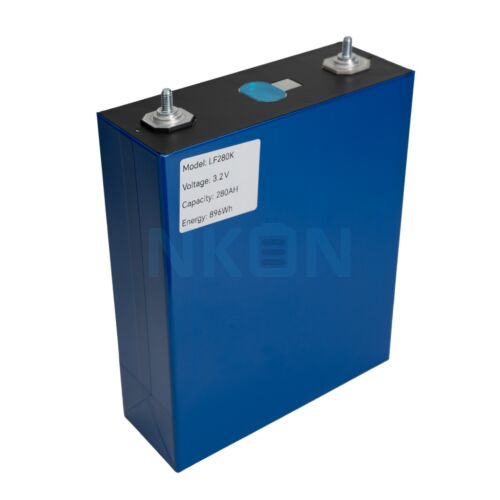Eve LF280K v3 - 280Ah - LiFePO4 3.2V - Grade A Single stud
Product specifications
Product description
Grade A: They are sorted by capacity.
Capacity: 280 Ah
Maximum discharge rate: 1C (280A)
Size: 72 mm x 207.5 mm x 172.5 mm
This is a 3.2V LiFePO4 cell.
The cells have a lifespan (to 80% capacity) of 8000 cycles when used with a pressure of 280–320 kg and charged at 0.5C (0.05C termination current to 3.65V), 0.5C discharge (to 2.5V).
With busbars.
With (aftermarket) studs.
22.5 cm height including mounted studs, busbars, and nuts.
Capacity report available.
For this batch: Capacity: 309–312Ah
IR 0.16–0.165 mΩ (@3.295V)
Average thickness: 71.638 mm (71.506–71.942)
Note: The internal resistance (IR) was measured before the terminals were added. Voltage and current probes were placed on opposite sides of the terminal. Typically, cell temperature during measurement is around 25°C.
Placing the probes closer together, measuring at the studs, or conducting measurements at lower cell temperatures will result in higher IR values.
Extra information
Reviews
- Buy 8 pieces for €64.35 Excl. Tax: €53.18 each
- Buy 16 pieces for €63.95 Excl. Tax: €52.85 each
- Buy 32 pieces for €63.35 Excl. Tax: €52.36 each
- Buy 64 pieces for €62.95 Excl. Tax: €52.02 each
Grade A: They are sorted by capacity.
Capacity: 280 Ah
Maximum discharge rate: 1C (280A)
Size: 72 mm x 207.5 mm x 172.5 mm
This is a 3.2V LiFePO4 cell.
The cells have a lifespan (to 80% capacity) of 8000 cycles when used with a pressure of 280–320 kg and charged at 0.5C (0.05C termination current to 3.65V), 0.5C discharge (to 2.5V).
With busbars.
With (aftermarket) studs.
22.5 cm height including mounted studs, busbars, and nuts.
Capacity report available.
For this batch: Capacity: 309–312Ah
IR 0.16–0.165 mΩ (@3.295V)
Average thickness: 71.638 mm (71.506–71.942)
Note: The internal resistance (IR) was measured before the terminals were added. Voltage and current probes were placed on opposite sides of the terminal. Typically, cell temperature during measurement is around 25°C.
Placing the probes closer together, measuring at the studs, or conducting measurements at lower cell temperatures will result in higher IR values.

